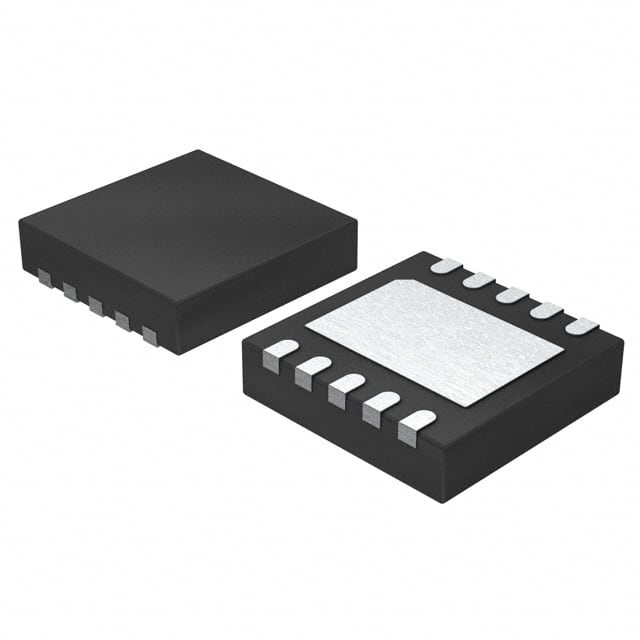Xem thông số kỹ thuật để biết chi tiết sản phẩm.

CAP1006-1-AIA-TR
Product Overview
Category
CAP1006-1-AIA-TR belongs to the category of integrated circuits (ICs).
Use
This product is primarily used for touch sensing applications.
Characteristics
- Integrated touch sensor IC
- High sensitivity and accuracy
- Low power consumption
- Compact size
- Easy integration into various devices
Package
The CAP1006-1-AIA-TR is available in a small surface mount package, making it suitable for compact electronic devices.
Essence
The essence of CAP1006-1-AIA-TR lies in its ability to provide reliable and accurate touch sensing capabilities for a wide range of applications.
Packaging/Quantity
The product is typically packaged in reels or tubes, with a quantity of 2500 units per reel/tube.
Specifications
- Supply Voltage: 2.5V - 5.5V
- Operating Temperature Range: -40°C to +85°C
- Communication Interface: I2C
- Number of Touch Inputs: 6
- Sensing Method: Mutual Capacitance
- Sensitivity Adjustment Range: 12-bit resolution
- Power Consumption: < 1µA in low-power mode
Detailed Pin Configuration
The CAP1006-1-AIA-TR features the following pin configuration:
- VDD - Power supply voltage
- SDA - I2C data line
- SCL - I2C clock line
- IRQ - Interrupt output
- GND - Ground
- TCH1 - Touch input 1
- TCH2 - Touch input 2
- TCH3 - Touch input 3
- TCH4 - Touch input 4
- TCH5 - Touch input 5
- TCH6 - Touch input 6
Functional Features
- Multi-touch sensing capability
- Proximity detection
- Automatic tuning for optimal performance
- Noise filtering and rejection
- Configurable sensitivity levels
- Interrupt-driven operation
Advantages and Disadvantages
Advantages
- High sensitivity and accuracy enable precise touch detection
- Low power consumption prolongs battery life in portable devices
- Compact size allows for easy integration into various electronic devices
- Automatic tuning ensures optimal performance in different environments
Disadvantages
- Limited number of touch inputs (6 in this case)
- Requires I2C communication interface for configuration and data exchange
Working Principles
The CAP1006-1-AIA-TR utilizes mutual capacitance sensing technology to detect touch inputs. It works by measuring changes in capacitance caused by the presence of a conductive object, such as a finger, near the touch sensor electrodes. The IC processes these capacitance changes and provides corresponding output signals.
Detailed Application Field Plans
The CAP1006-1-AIA-TR is widely used in various applications, including but not limited to: - Consumer electronics (smartphones, tablets, remote controls) - Home appliances (touch-sensitive control panels) - Automotive industry (infotainment systems, touchscreens) - Industrial automation (human-machine interfaces) - Medical devices (patient monitoring, touch-based controls)
Detailed and Complete Alternative Models
Some alternative models that offer similar functionality to CAP1006-1-AIA-TR include: - CAP1188-1-BIA-TR - CAP1298-1-BIA-TR - AT42QT1010-TSHR - TTP223N-BA6
These alternatives may have slightly different specifications or pin configurations, but they serve the same purpose of touch sensing in electronic devices.
Word count: 452 words
Liệt kê 10 câu hỏi và câu trả lời thường gặp liên quan đến ứng dụng CAP1006-1-AIA-TR trong giải pháp kỹ thuật
Sure! Here are 10 common questions and answers related to the application of CAP1006-1-AIA-TR in technical solutions:
Q1: What is CAP1006-1-AIA-TR? A1: CAP1006-1-AIA-TR is a technical reference document that provides guidelines and best practices for implementing the CAP1006-1-AIA standard in technical solutions.
Q2: What is the purpose of CAP1006-1-AIA-TR? A2: The purpose of CAP1006-1-AIA-TR is to ensure consistent and effective implementation of the CAP1006-1-AIA standard in technical solutions, promoting interoperability and compatibility.
Q3: How can I access CAP1006-1-AIA-TR? A3: CAP1006-1-AIA-TR can be accessed through the official website of the organization responsible for maintaining the standard or through authorized distributors.
Q4: Is CAP1006-1-AIA-TR mandatory for implementing CAP1006-1-AIA? A4: CAP1006-1-AIA-TR is not mandatory but highly recommended as it provides valuable guidance and best practices for successful implementation of the CAP1006-1-AIA standard.
Q5: Can CAP1006-1-AIA-TR be used for other technical solutions apart from CAP1006-1-AIA? A5: CAP1006-1-AIA-TR is specifically designed for the implementation of CAP1006-1-AIA. However, some of the principles and guidelines mentioned in the document may be applicable to other similar standards.
Q6: Are there any specific hardware or software requirements mentioned in CAP1006-1-AIA-TR? A6: CAP1006-1-AIA-TR does not provide specific hardware or software requirements. It focuses on the implementation and usage of the CAP1006-1-AIA standard rather than technical specifications.
Q7: Can CAP1006-1-AIA-TR be customized for specific technical solutions? A7: CAP1006-1-AIA-TR can be customized to some extent based on the specific needs and requirements of a technical solution. However, it is important to ensure that any customization aligns with the core principles of the CAP1006-1-AIA standard.
Q8: Does CAP1006-1-AIA-TR provide troubleshooting guidelines? A8: CAP1006-1-AIA-TR may include some troubleshooting guidelines, but its primary focus is on providing implementation guidance rather than addressing specific technical issues.
Q9: Is CAP1006-1-AIA-TR regularly updated? A9: CAP1006-1-AIA-TR may be periodically updated to reflect changes in the CAP1006-1-AIA standard or to incorporate new best practices and industry trends.
Q10: Can I use CAP1006-1-AIA-TR as a standalone document for implementing CAP1006-1-AIA? A10: While CAP1006-1-AIA-TR provides valuable guidance, it is recommended to refer to the CAP1006-1-AIA standard itself for a comprehensive understanding of the technical requirements. CAP1006-1-AIA-TR should be used as a supplementary document to aid in the implementation process.

